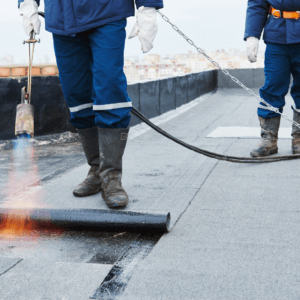Modified bitumen might sound like a character from a Tolkien novel, but it’s actually a standard commercial roofing material. Who knew, right? Your Altamonte Springs roofer did!
When looking for an Altamonte Springs roofer to install or maintain your commercial roof, you must find a company with modified bitumen experience. This sturdy asphalt material is popular for flat roofs because of its durability and water resistance. It takes special skills to install and repair, however, and you don’t want to leave the protection of your business to a company without flat roof expertise.
Advantage Roofing has served Central Florida for 35 years. Our team is licensed, insured, and knowledgeable about all roofing materials, so you can trust your commercial roof with our Altamonte Springs roofers. Here, we explain modified bitumen and why it’s a smart choice for your roof.
Unmodified Bitumen – Where It Started
Let’s start with bitumen before it’s modified for roofing. Unmodified bitumen, or traditional or straight-run bitumen, is a naturally occurring, viscous, black, and sticky substance derived from crude oil through fractional distillation. It is commonly used in road construction, waterproofing, and as a binder in asphalt concrete for pavement.
Modified Bitumen History
Modified bitumen roofing was developed in the 1960s and improved traditional asphalt roofing by adding modifiers like SBS (Styrene-Butadiene-Styrene) or APP (Atactic Polypropylene) for better durability and weather resistance. Its popularity increased in the following years because it effectively waterproofed flat roofs and extended their lifespan. Today, it’s still a trusted choice for commercial and residential buildings.
What Is Modified Bitumen?
Modified bitumen is a type of asphalt roofing material. Additives must be introduced to make unmodified bitumen suitable for roofing. Polymers and other additives enhance this substance’s performance, making it more elastic, durable, and temperature-resistant. You can see why it’s a popular choice for low-slope or flat roofing applications.
How Is Modified Bitumen Applied?
Modified bitumen typically comes in rolls and is applied to the roof surface using various adhesives such as torches, hot mops, or cold-applied adhesives. Modified bitumen roofs are known for their longevity and ability to withstand weather conditions like those we regularly see in Florida.
Types of Modified Bitumen
This roofing material is not a “one size fits all” solution. Your Altamonte Springs roofer can guide you in choosing the best option for your property.
SBS (Styrene-Butadiene-Styrene)
SBS-modified bitumen roofing is a common type of roofing material known for its flexibility and resistance to low temperatures. Installation methods include hot asphalt, cold adhesive, or heat welding.
APP (Atactic Polypropylene)
APP-modified bitumen roofing offers exceptional resistance to high temperatures and UV radiation. It utilizes a thermoplastic polymer and is typically applied using torch-on or heat-welding methods.
Self-Adhesive Modified Bitumen
Self-adhesive modified bitumen is gaining popularity for its easy installation. These membranes have an adhesive backing for direct application to the roof substrate. Available in both SBS and APP formulations, this material still requires installation by an experienced Altamonte Springs roofer.
Hybrid Modified Bitumen Roofing
Hybrid systems combine the benefits of SBS- and APP-modified bitumen, offering flexibility in cold weather and resistance to high temperatures. They are ideal for regions with extreme climate variations.
Base and Cap Sheets
Modified bitumen roofing typically comprises a base sheet for primary waterproofing and a cap sheet for additional protection and aesthetic appeal. Cap sheets may feature various surface materials, including granules, reflective coatings, or metal.
Torch-Applied and Cold-Applied Systems
Installation methods for modified bitumen include torch-on techniques, using heat to bond layers, and cold-applied systems utilizing adhesives or self-adhesive membranes, eliminating the need for open flames.
Peel-and-Stick Systems
Some modified bitumen membranes come with a peel-and-stick backing, simplifying installation and reducing the need for hot asphalt or torches.
White and Reflective Roofing
Reflective modified bitumen options aim to reduce heat absorption, enhancing energy efficiency. White and reflective coatings help maintain cooler building temperatures and lower energy costs.
Get Top Quality Modified Bitumen From Your Expert Altamonte Springs Roofer
The modified bitumen roofing type you choose depends on your climate, building design, budget, and desired performance characteristics. Contact Advantage Roofing for assistance in determining the best option for your specific project. We look forward to working with you!
